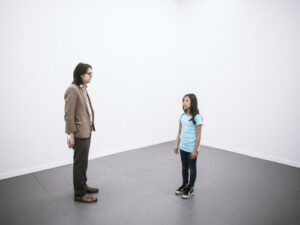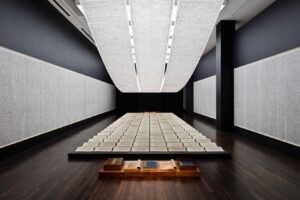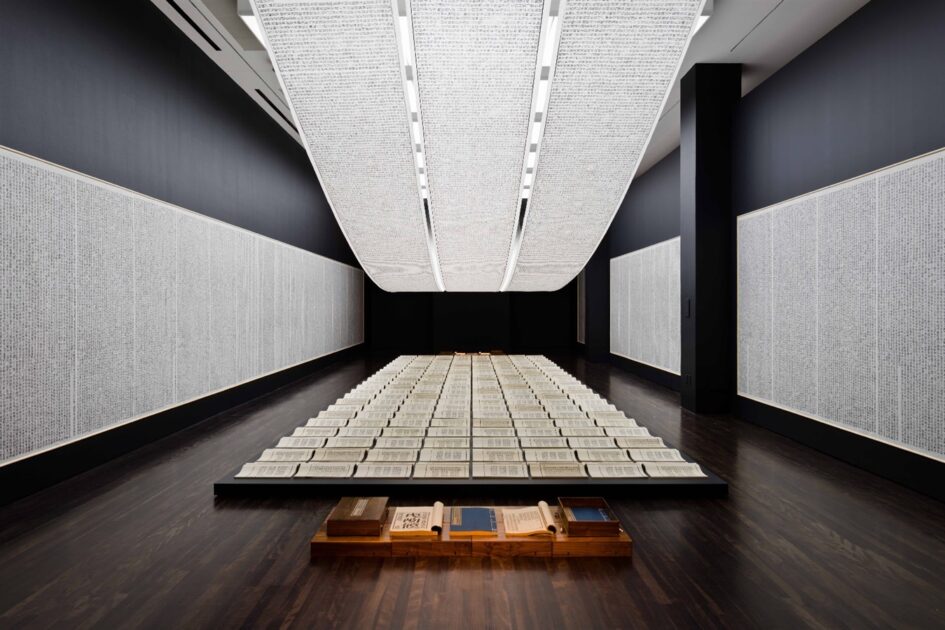I have changed my mind, once my interest was focused on positive narratives in eco-art, and my curatorial idea was to curate art exhibitions focusing on the symbiosis between human and nature. But after I read I read Language and Silence by George Steiner (Steiner, 1975), my curatorial direction shifted. I began to think about the limitations of language and how it affects our perception of the world. In his book, Steiner explores how language is both a tool for expressing ideas and an obstacle that prevents certain ideas from being spoken. This theory prompted me to re-examine the practice of de-lingualisation in contemporary art and to consider how curation can transcend the shackles of symbols and explore the possibility of communication without language.
I would like to curate an exhibition with the theme of ‘The World of De-Language’. It focuses on how contemporary art challenges the power structure of language and constructs new ways of perception between the gaps of symbols. Through a variety of media, we try to deconstruct the hegemony of language and find a path of expression that is closer to intuition, instinct and emotion.
The duality of language has always been an important issue in philosophy, literature and art. From Wittgenstein (1953) to Derrida (1976), the boundaries of language and its ability to shape reality have received widespread attention. In his Philosophical Investigations, Wittgenstein suggests that ‘the boundaries of language are the boundaries of thought’ (Wittgenstein, 1953), while Derrida’s deconstructionism emphasises the constructive nature of language and its internal contradictions (Derrida, 1976). Steiner goes further, stating that silence is not the antithesis of language, but rather its limit. Where language cannot reach, can art fill the gap?
In the course of this research, I read Jacques Rancière’s (Rancière, 2009) The Emancipation of the Spectator, in which he emphasises how the viewer can decipher meaning in art rather than just passively accepting an established textual narrative. Combined with Steiner’s theories, I began to realise how contemporary curation could challenge the hegemony of language and create a more immersive and participatory experience for the viewer.
In the process of exploring ideas and finding materials, I focused on a number of language-related artists to get a feel for the use of language in artworks.Tino Sehgal’s works emphasise physical and behavioural expression, such as This Progress, which allows participants to experience the flow of ideas through interaction (Sehgal, 2012). However, there is not a de-verbalisation, only a relative emphasis on the expression of physical behaviour. As well as Rafael Lozano-Hemmer’s Voice Array, when a participant speaks into a walkie-talkie, his or her voice is automatically converted into flashes of light, and the unique pattern of flashes is then stored as a loop in the first light of the array. Each new recording pushes all previous recordings down one position, and gradually the cumulative sound of 288 previous recordings can be heard. The sounds being pushed out of the array can then be heard individually.

This Progress. Tino Seghal. (2006, 2010, 2016)
Continuing my research into de-verbalised artistic expression, I also focused on Xu Bing’s Tianshu, a series of textual works that appear to be Chinese characters but are completely indecipherable. These ‘characters’ mimic the visual form of the traditional writing system, but cannot be assigned a fixed meaning, thus challenging the essential function of the written word; Xu Bing’s works emphasise the arbitrary nature of language and allow the viewer to rethink the symbol when confronted with these indecipherable ‘characters’. Xu Bing’s works emphasise the arbitrariness of language and allow the viewer to rethink the relationship between symbols and meaning when confronted with these indecipherable ‘words’.

2016 ‘Xu Bing: Book of Heaven’ Blanton Museum of Art, University of Texas at Austin, Texas, USA
My curatorial proposal will be centred around the works of these different artists, and through the exhibition, I will lead the audience to consider: if words and language are no longer the main tools of communication, can we understand them in other ways? Can art help us discover deeper modes of communication? Can this non-verbal experience make up for the limitations of language? These questions will be the direction of the exhibition’s exploration and will hopefully provide the audience with an experience that transcends the boundaries of language.
References
Derrida, J. (1976). Of Grammatology. Johns Hopkins University Press.
Rancière, J. (2009). The Emancipated Spectator. Verso Books.
Steiner, G. (1975). Language and Silence: Essays on Language, Literature, and the Inhuman. Yale University Press.
Wittgenstein, L. (1953). Philosophical Investigations. Blackwell.



Leave a Reply